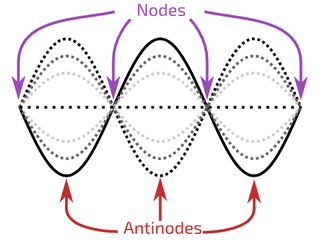Standing wave seems to be a contradiction of terms. A wave should always be moving. But in fact standing wave is a situation in resonance, where a wave, reflecting off a surface is interacting with itself, resulting what we refer to as a standing wave.
In other words, its an example of interference.
The principle of standing waves has many application ranging from music, to microwave ovens, to quantum mechanics.
In other words, its an example of interference.
The principle of standing waves has many application ranging from music, to microwave ovens, to quantum mechanics.
Interactive
Let's first explore why a standing wave is produced
Let's first explore why a standing wave is produced
- Set the type to pulse, have damping to zero, and fixed end
- Now send down a single pulse - You will note that it reflects and switches side, or changes phase
- If you send another pulse whilst the previous one is returning, they will interfere with each other.
This is key to standing waves, but this only occurs at set frequencies, Let's see this in action.
- Set the system to oscillate, damping zero and fixed end
- If you press play you will see that you might get a standing wave when the reflected wave interferes with the coming wave.
- But the frequency (1.5 Hz) is not quite right. It may behave as a standing wave for a short time, but eventually it will become chaotic.
- See if you can alter the frequency slightly to make a standing wave. Press restart when you do this
Hopefully you will see that you will get a large amplitude (its in resonance) but the position of these amplitude does to move to the left or right (Hance its standing wave)
|
|
Theory
In the first in a series of videos I discuss the principles of a transverse standing wave using a guitar and a string to demonstrate and explain. |
Sample Problem
We are now ready to try a sample problem
Below is a sample problem with a video that explain how to solve it. It is suggested you try the problem beforehand, as this actually aids understanding, even if you are unsure if you are correct.
We are now ready to try a sample problem
Below is a sample problem with a video that explain how to solve it. It is suggested you try the problem beforehand, as this actually aids understanding, even if you are unsure if you are correct.
Interactive
Here is another Standing wave in string interactive developed in Geogebra by Tom Walsh. Again, you will notice only specific frequencies will result in a standing wave
Here is another Standing wave in string interactive developed in Geogebra by Tom Walsh. Again, you will notice only specific frequencies will result in a standing wave
|
|
Closed pipes
Standing waves can also occur in sound, where the medium is not a string, but air itself. Many musical instruments rely on the principle of standing waves and resonance of sound. In the second video I examine the standing waves in closed pipes, and explain the mathematical models associated with it. |
Sample Problem
Interactive
In this animation you can explore both the standing wave in longitudinal form as well as the transverse form used in representations
Standing wave in pipe interactive developed in Geogebra by Tom Walsh
In this animation you can explore both the standing wave in longitudinal form as well as the transverse form used in representations
Standing wave in pipe interactive developed in Geogebra by Tom Walsh
Standing Waves in 2 dimensions - Chladni plates
In the previous examples we were looking at standing waves in one dimension. However standing waves can occur in two and three dimensions. Chladni plates provide a fascinating visual representation of standing waves in 2 dimensions, this video will discuss the principles of how it works.
Applications
As the above videos demonstrate, there are applications for standing waves, most obviously the production and use of musical instruments
There are other applications
As the above videos demonstrate, there are applications for standing waves, most obviously the production and use of musical instruments
There are other applications



